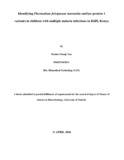| dc.description.abstract | The Plasmodium falciparum Merozoite Surface Protein 1(Pf MSP1), a predominant antigen on the surface of the asexual blood stage of the parasite, plays a role in erythrocyte invasion. It elicits immune responses during exposure to natural P. falciparum infections, hence, it is a potential vaccine candidate. However, its extensive sequence diversity causes antigenic variability. Parasites that express variants other than that targeted by immune protection mounted as a result of a vaccine variant, evade the resultant host immune protection. This compromises the efficacy of allele-specific vaccines formulated to protect against a single variant. Due to this, Pf MSP1 has been extensively studied, including in Kenya. However, the extent of Pf MSP1 diversity in children with multiple infections are unknown in Kilifi which is a moderate to high malaria transmission zone. Parasite genomic DNA was extracted from 421 blood samples in 33 children aged below 5 years who had at least 9 multiple infections. The Pf MSP119kDa region was amplified by Polymerase Chain Reaction (PCR). Samples that generated good amplicons were sequenced and analysed for allelic polymorphisms using Sequencher 5.3 and MEGA 5.2 softwares. Sequence clustering and haplotype frequencies were done in 150 samples that generated unambiguous sequences using the Phyclust package in R programming and command line in executable USEARCH software. A total of 11 haplotypes distributed randomly across the infection episodes were identified. The Q-KSNG-L(36%), E-KSNG-L(26%) and Q-KSNG-F(18%) haplotypes were the most prevalent in this population. These haplotypes were mainly observed 2 to 3 times between consecutive infections in some children. Following such a pattern, the variants did not re-appear in the subsequent isolates from the respective child. This was due to the host immune responses that protected against those variants which were previously exposed to the child. The E-TSSR-L variant, corresponding to P. falciparum 3D7 isolate, a widely used allele for vaccine formulation, had a very low frequency (1.3%). These findings provide useful information in designing future multi-allelic malaria vaccines for deployment in endemics. | en_US |

